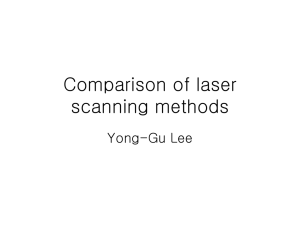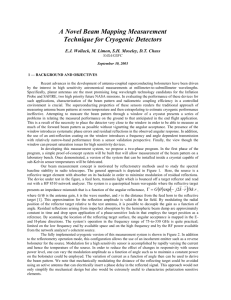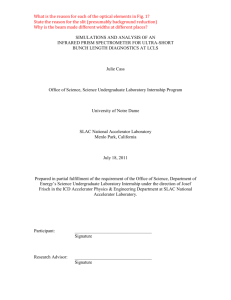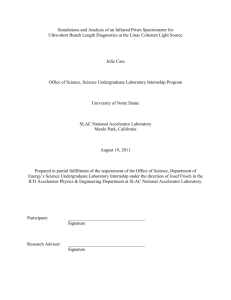Julie Cass
advertisement
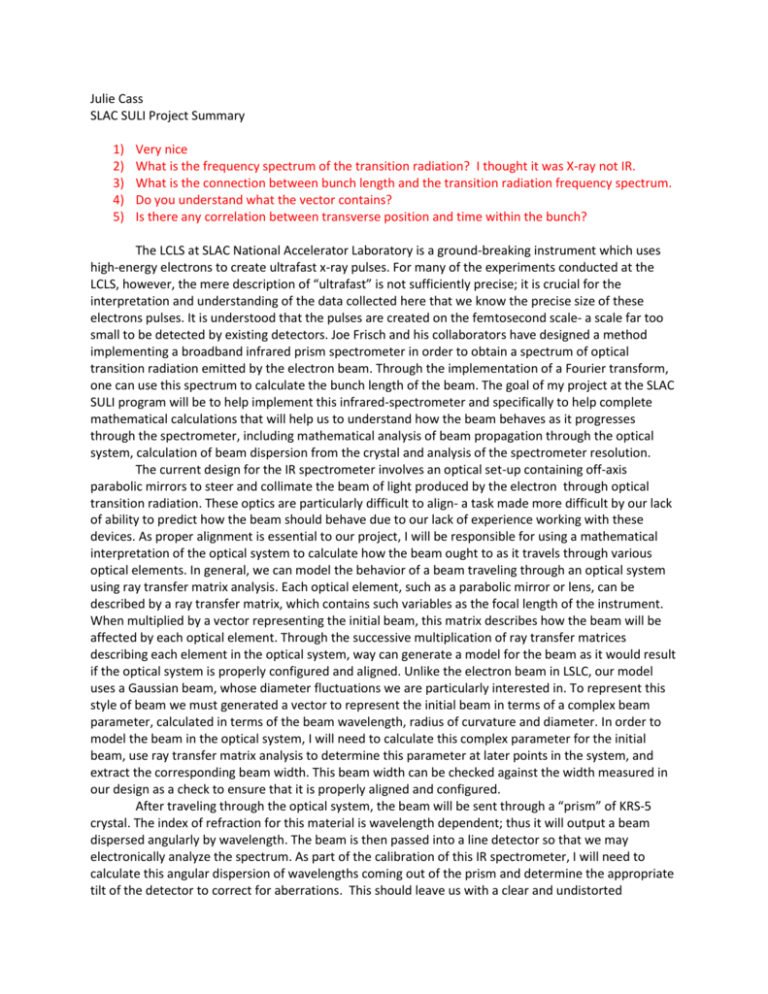
Julie Cass SLAC SULI Project Summary 1) 2) 3) 4) 5) Very nice What is the frequency spectrum of the transition radiation? I thought it was X-ray not IR. What is the connection between bunch length and the transition radiation frequency spectrum. Do you understand what the vector contains? Is there any correlation between transverse position and time within the bunch? The LCLS at SLAC National Accelerator Laboratory is a ground-breaking instrument which uses high-energy electrons to create ultrafast x-ray pulses. For many of the experiments conducted at the LCLS, however, the mere description of “ultrafast” is not sufficiently precise; it is crucial for the interpretation and understanding of the data collected here that we know the precise size of these electrons pulses. It is understood that the pulses are created on the femtosecond scale- a scale far too small to be detected by existing detectors. Joe Frisch and his collaborators have designed a method implementing a broadband infrared prism spectrometer in order to obtain a spectrum of optical transition radiation emitted by the electron beam. Through the implementation of a Fourier transform, one can use this spectrum to calculate the bunch length of the beam. The goal of my project at the SLAC SULI program will be to help implement this infrared-spectrometer and specifically to help complete mathematical calculations that will help us to understand how the beam behaves as it progresses through the spectrometer, including mathematical analysis of beam propagation through the optical system, calculation of beam dispersion from the crystal and analysis of the spectrometer resolution. The current design for the IR spectrometer involves an optical set-up containing off-axis parabolic mirrors to steer and collimate the beam of light produced by the electron through optical transition radiation. These optics are particularly difficult to align- a task made more difficult by our lack of ability to predict how the beam should behave due to our lack of experience working with these devices. As proper alignment is essential to our project, I will be responsible for using a mathematical interpretation of the optical system to calculate how the beam ought to as it travels through various optical elements. In general, we can model the behavior of a beam traveling through an optical system using ray transfer matrix analysis. Each optical element, such as a parabolic mirror or lens, can be described by a ray transfer matrix, which contains such variables as the focal length of the instrument. When multiplied by a vector representing the initial beam, this matrix describes how the beam will be affected by each optical element. Through the successive multiplication of ray transfer matrices describing each element in the optical system, way can generate a model for the beam as it would result if the optical system is properly configured and aligned. Unlike the electron beam in LSLC, our model uses a Gaussian beam, whose diameter fluctuations we are particularly interested in. To represent this style of beam we must generated a vector to represent the initial beam in terms of a complex beam parameter, calculated in terms of the beam wavelength, radius of curvature and diameter. In order to model the beam in the optical system, I will need to calculate this complex parameter for the initial beam, use ray transfer matrix analysis to determine this parameter at later points in the system, and extract the corresponding beam width. This beam width can be checked against the width measured in our design as a check to ensure that it is properly aligned and configured. After traveling through the optical system, the beam will be sent through a “prism” of KRS-5 crystal. The index of refraction for this material is wavelength dependent; thus it will output a beam dispersed angularly by wavelength. The beam is then passed into a line detector so that we may electronically analyze the spectrum. As part of the calibration of this IR spectrometer, I will need to calculate this angular dispersion of wavelengths coming out of the prism and determine the appropriate tilt of the detector to correct for aberrations. This should leave us with a clear and undistorted spectrum at the detector. Finally, the importance of detecting the spectrum of the beam is to determine the form factor so that we may conduct an inverse Fourier transform to find the associated bunch length. My project will include determining the method and mathematical calculations needed in order to output a bunch length from the spectrum produced by our spectrometer.




